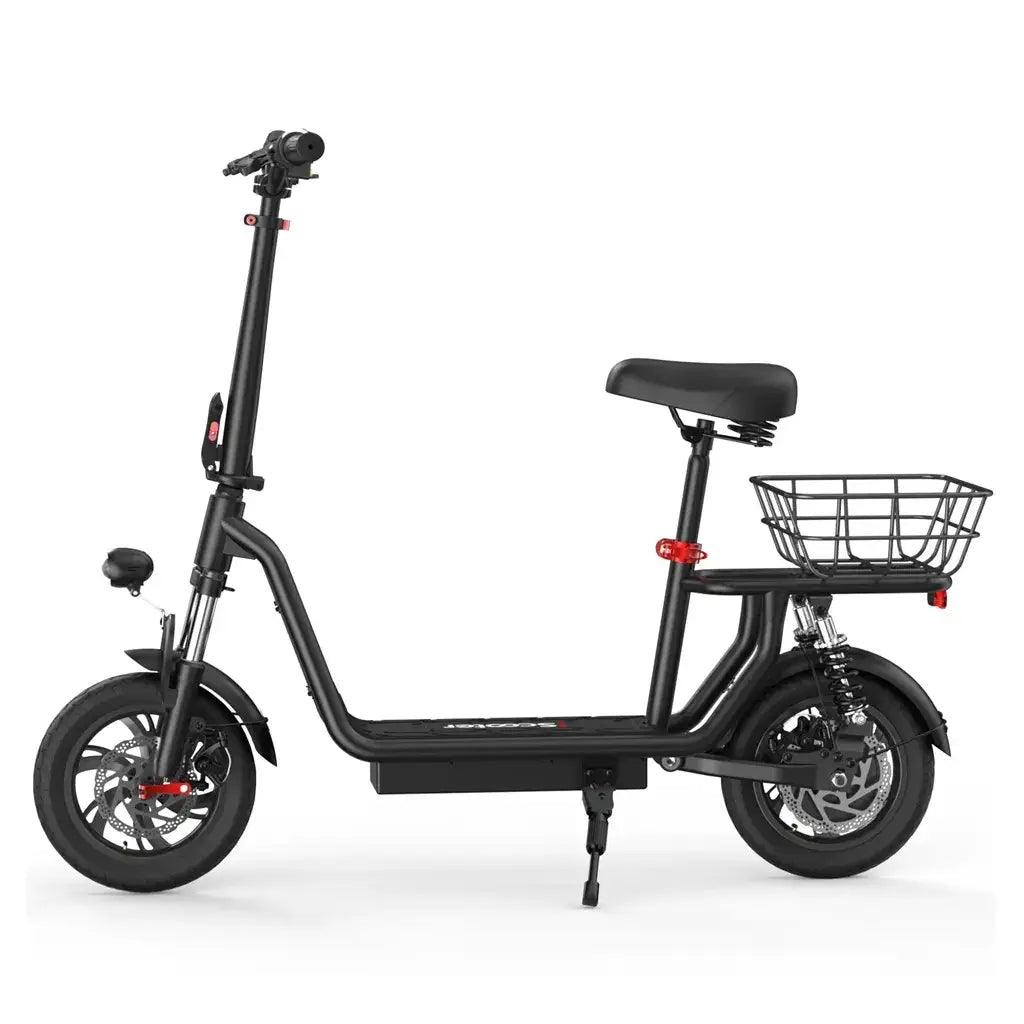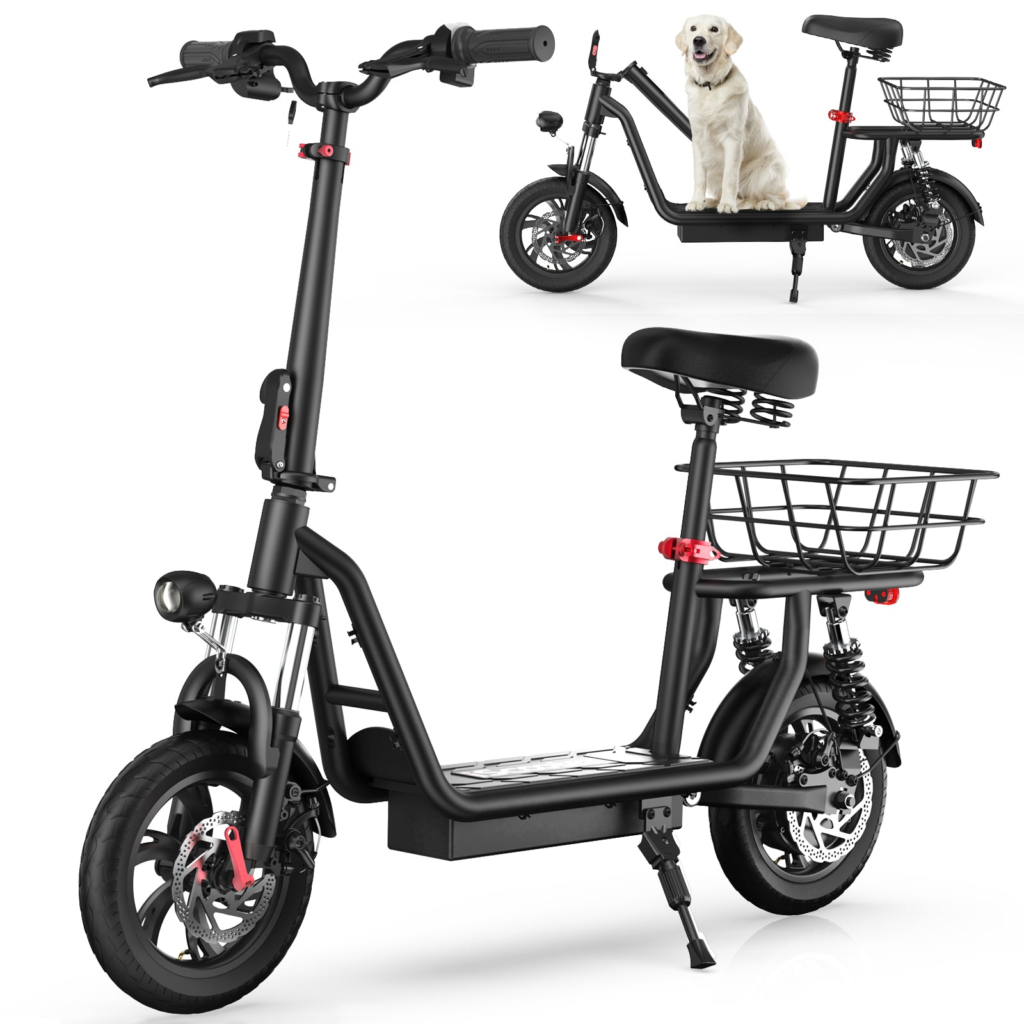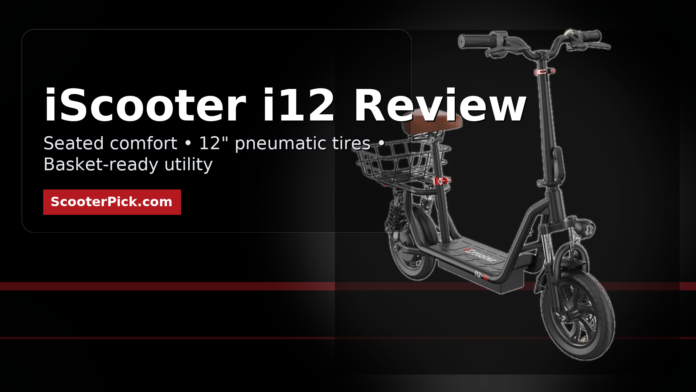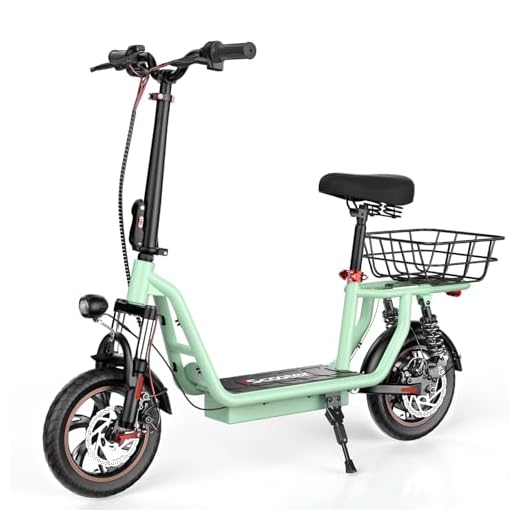If you want a sit-down, basket-equipped scooter for errands and short commutes, the iScooter i12 lands in a sweet spot of comfort and simplicity. It pairs a 500W rear hub motor with 12-inch pneumatic tires and dual suspension, which softens rough patches better than most compact commuters. In this iScooter i12 review, you’ll learn how it rides, what it does well, and where it asks for trade-offs. For quick specs, you can also view the product page for the iScooter i12.
Key Specifications
| Block | Item | Detail |
|---|---|---|
| General | Model | iScooter i12 |
| Riding Style | Seated scooter with rear cargo basket | |
| Drive | Rear-wheel hub motor | |
| Age Guidance | 14+ | |
| Max Rider Load | 264 lb (120 kg) | |
| Performance & Power | Motor Power | 500W rear hub |
| Top Speed | Up to 15.6 mph (25 km/h) | |
| Hill Grade (claimed) | Up to ~15% on short inclines | |
| Tires | 12″ pneumatic (front & rear) | |
| Charging & Electrical | Battery | 36V 7.5Ah (270 Wh) |
| Charger | 42V 1.5A | |
| Charge Time | ~5–6 hours from low | |
| Display | Simple battery-bar indicator | |
| Build & Dimensions | Frame | Folding handlepost; wide standing deck; rear cargo rack |
| Unfolded Dimensions (L×W×H) | 49.6 × 23.6 × 45.6 in (1260 × 600 × 1160 mm) | |
| Folded Dimensions (L×W×H) | 49.6 × 23.6 × 42.8 in (1260 × 600 × 1087 mm) | |
| Net Weight | ~45 lb (20.4 kg) | |
| Handlebar/Seat | Height-adjustable handlebar and saddle | |
| Safety & Control | Brakes | Dual mechanical disc brakes (front & rear) |
| Lighting | Front headlight + rear tail/brake light | |
| Acoustic Alert | Bar-mounted horn | |
| Ignition | Keyed on/off | |
| Features & Extras | Rear Basket | Included metal cargo basket |
| Suspension | Dual suspension (front and rear) | |
| Cruise Control | Not available | |
| App | Basic settings support on select batches (e.g., zero-start toggle) | |
| Warranty & Compliance | Warranty | 12 months (typical manufacturer policy) |
| Water Exposure | Not waterproof; avoid riding in rain or through puddles |
Notes: Real-world top speed and range vary with rider weight, temperature, terrain, and tire pressure. Keep tires at recommended PSI for best performance and puncture resistance.
Design & Build Quality
At first glance, the i12 does not try to be a featherweight; it aims for stability and everyday utility. The integrated rear rack and included basket change how you use a scooter. You can carry groceries, a backpack, or lightweight tools without wearing a pack. Because weight sits over the rear wheel, the scooter feels planted when you accelerate or brake on flat streets.
The chassis uses a folding handlepost secured by a latch and a safety catch. It’s a simple clamp-style design you can see and feel, which inspires more confidence than hidden, tool-free gimmicks. The deck is broad and flat, so you can rest both feet comfortably. Meanwhile, the saddle and handlebar height adjustments allow different rider sizes to find a neutral posture. You sit upright, which reduces wrist strain and improves low-speed control around pedestrians.
Wiring is exposed in practical places yet routed cleanly. You’ll see standard bicycle-style brake calipers at both wheels, which makes pad alignment familiar for anyone who’s adjusted a mechanical disc brake. The 12-inch pneumatic tires add diameter compared with typical 8.5–10-inch commuter wheels, and that extra radius helps roll through cracks and broken asphalt more smoothly.
Finish quality is consistent for the category. Paint and fasteners look serviceable rather than flashy. The headlight sits high enough to be useful at neighborhood speeds, and the tail light doubles as a brake light, which improves signaling. Because the scooter includes a horn and key ignition, it feels more “vehicle-like,” which some riders appreciate when parking outside shops.

Motor, Power & Acceleration
With a 500W rear hub, the i12 accelerates progressively rather than abruptly. That’s ideal for a seated, utility-minded scooter because your weight is already distributed rearward. From a stop, it rolls forward smoothly, then builds to cruise pace without sudden surges. This behavior helps new riders feel in control and keeps traction steady over painted lines, bricks, or compact gravel.
Against light urban traffic, you won’t snap away from the line like a performance scooter. However, the twist-grip throttle gives granular input; small wrist movements translate to small speed changes. As a result, tight sidewalk approaches, curb cuts, and shared paths are easier to manage. On flat paths, it reaches neighborhood top speed promptly, then holds it with modest motor whine.
Climbing matters. On short, moderate hills around 7–8% grade, the i12 continues moving with a lighter rider and proper tire pressure. Heavier riders or longer hills will slow it more noticeably. You can help it with a few pedal-like scoots or by carrying momentum before the incline. Because the motor sits in the rear, traction remains predictable when you stand briefly to unweight the saddle over a bump or seam.
Battery, Range & Efficiency
The 36V 7.5Ah pack suits short-to-medium errands. Under favorable conditions—temperate weather, conservative speeds, and moderate rider weight—you can expect a practical errand loop without mid-trip anxiety. Cold temperatures reduce range, as they do on every lithium pack. Therefore, plan conservatively in winter and recharge indoors.
Efficiency depends heavily on tire pressure and how often you stop. Those 12-inch tubes should be checked weekly. When they drift lower, rolling resistance rises and range falls. Keep a small bicycle pump handy, and verify PSI before longer rides. Additionally, carrying cargo in the rear basket changes aero drag and weight distribution. Heavier, bulky loads shorten range, especially if streets are hilly or winds are strong.
Riders often wonder about battery bars. The i12’s display uses three segments; it gives a quick sense of remaining energy but not the precision of a percentage readout. Expect the first bar to last the longest, then faster drop-off near the end, particularly if you demand full speed. This is normal for small packs under higher current draw.
Ride Quality, Handling & Comfort
Seat height and handlebar reach define the i12’s character. Set them correctly and you’ll sit upright with relaxed elbows. Because the fork and rear end use coil-spring suspension, the scooter filters out chatter from brickwork, patched asphalt, and manhole edges. You still feel bigger hits, yet the system avoids the bouncy “pogo” sensation that softer, longer-travel setups sometimes create at this weight and speed.
The 12-inch tire diameter is the quiet hero. It rolls through pothole edges more cleanly and keeps steering calmer at top speed. Moreover, the wider deck lets you shift foot placement to relieve pressure points during longer rides. On paint lines in the wet or loose grit at intersections, the rear-drive layout helps the front stay light and steerable.
Low-speed balance is easy to learn. Because you’re seated, you can dab a foot during tight U-turns or when creeping along a busy sidewalk. The twist-grip throttle feels natural for bicycle converts, and the horn helps you signal your presence at path crossings. Meanwhile, the padded saddle takes the edge off expansion joints and curb entries. If you regularly ride broken pavement, the i12’s wheel size and seat combine to keep fatigue in check.

Braking & Safety Features
Dual mechanical discs are a practical, serviceable choice. Lever feel is predictable, and stopping power suits the scooter’s weight and speed. With both calipers tuned, the i12 slows in a straight line without sudden over-the-bars moments. Because you sit, weight transfer forward is milder than on a standing deck, which keeps the rear tire contributing longer under braking.
The lighting package covers the basics. A bar-mounted headlight improves conspicuity at dusk and helps you spot surface changes at neighborhood speeds. The tail light brightens under braking, which is important in mixed traffic. Add reflective clothing or a secondary clip-on light if you ride at night frequently, since low-mounted lights on any scooter can get lost among car headlights.
Finally, the key ignition adds a deterrent. It won’t stop a determined thief, but it prevents casual tampering outside shops. Always lock the frame through the rear rack or wheel when parking longer than a quick stop.
Portability & Daily Usability
This is not a featherweight commuter, and that’s by design. At roughly 45 pounds (20.4 kg) with a basket and seat, the i12 favors rolling utility over daily shoulder carrying. You can fold the handlepost to reduce height for a car trunk or hallway storage. Even so, the scooter remains relatively tall when folded because of the seat and rack.
For apartment dwellers, think about route and storage. If you must climb several flights of stairs, you’ll appreciate a landing mid-way. Otherwise, consider a ground-floor bike room. On the flip side, the basket saves you from a backpack on hot days. Quick errands feel casual: roll up, lock the frame, grab your items, and go.
Daily rituals matter too. The charge port sits within easy reach, and the bar-graph display gives quick feedback before you head out. Because the i12 uses common bicycle-style brake hardware, a local bike shop can help you adjust pads or replace cables. This keeps maintenance costs lower than on some proprietary brake systems.
Features, App & Extras
The included metal basket is the standout extra. It’s sturdy enough for groceries, a laptop bag, or a light tool kit. You can also zip-tie a small liner or use a fabric tote to keep items from rattling. The horn, headlight, and tail/brake light continue the “street-ready” theme, while the key ignition adds a simple control point for families.
Some production runs allow basic app pairing to toggle settings such as zero-start. If your unit supports this, you’ll be able to choose whether the scooter requires a small push before the throttle engages. That setting adds safety for new riders and children in shared spaces. Just remember, the i12 keeps its interface simple—no advanced dashboard views or ride logs.
There’s no cruise control. Given the seated posture and twist throttle, most owners won’t miss it. You can rest your wrist by varying grip position during longer, steady runs on bike paths.

Charging Experience & Maintenance
Charging is straightforward: connect the 42V 1.5A brick, wait around five to six hours from low, and store the scooter indoors. Lithium batteries prefer moderate temperatures. Therefore, avoid leaving the i12 in a hot car or on a freezing balcony. After rides in the cold, let the battery warm back to room temperature before charging.
Check tires weekly. Set both to the recommended PSI listed on the sidewall (commonly around the mid-30s psi for this size). Under-inflation invites pinch flats and reduces range. Over-inflation sharpens steering and ride harshness. Find a balance that fits your weight and local roads.
Mechanical disc brakes need periodic attention. If a rotor scrapes, center the caliper and snug the bolts evenly. If the lever feels mushy, turn the barrel adjuster to take up slack or advance the cable at the caliper. Because pads bed in over the first few rides, a little noise at the start is normal. Keep rotors free of chain oil or silicone sprays.
Finally, protect the electronics. The i12 is not waterproof. Don’t hose it down or ride through standing water. Wipe it with a damp cloth, and dry it before storage. A simple cover helps in dusty garages.
Who the iScooter i12 Is For
If you want a seated scooter that trades outright speed for comfort and carry capacity, the i12 fits well. New riders will appreciate the gentler throttle response and planted stance from the 12-inch wheels. Riders managing knee or back sensitivity can sit, relax their core, and let the suspension do its work. Meanwhile, suburban errand-runners will love the basket for quick grocery pickups or postal runs.
Heavier commuters or riders facing long, steep climbs should calibrate expectations. The i12 can crest short grades, yet extended hills demand patience and planning. If your route includes frequent stair carries or tight elevator doors, remember the scooter’s height and weight. However, if you mainly roll from garage to path to storefront, the i12’s format is remarkably convenient.
Value for Money & Verdict (iScooter i12 review insights)
Viewed as a utility tool, the i12 makes a strong case. It doesn’t chase headline speed or exotic features. Instead, it prioritizes everyday details that change how often you ride: a comfortable saddle, bigger tires, dual suspension, and a real basket. Therefore, short errands feel easy, and neighborhood loops become part of your weekly routine.
Trade-offs exist. The display is basic, cruise control is absent, and folded height remains tall. Additionally, the three-bar battery gauge lacks precision, and the scooter’s mass discourages frequent stair carries. Even so, the ride comfort and practicality outweigh those drawbacks for its intended use. If that’s your scenario, the i12 earns a place near the top of your shortlist.
Comparing formats? Check the MAXSHOT X1 for a sportier standing commuter that prioritizes agility over a seated, basket-equipped setup.
Pros & Cons
Pros
- Comfortable seated posture with height-adjustable handlebar and saddle
- 12-inch pneumatic tires and dual suspension smooth rough pavement
- Dual mechanical disc brakes provide consistent, familiar stopping power
- Rear basket included; genuinely useful for errands
- Key ignition and horn add practical, street-friendly touches
- Stable, predictable throttle response for new riders
- Simple maintenance using common bicycle-style parts
Cons
- Heavier than stand-up commuters; not ideal for stairs
- No cruise control; display uses coarse battery bars
- Folded height still tall due to seat and rack
- Modest top speed; longer hills slow progress
- Not waterproof; requires careful storage and cleaning
- Range depends strongly on tire pressure and load
- Basic electronics; limited app functionality on some units
Price
FAQs
Does the i12 work for taller riders?
Yes. Because both the handlebar and seat adjust, taller riders can set a neutral reach. However, check folded height if you must store it under a low shelf.
Can I ride in light rain?
You shouldn’t. The scooter is not waterproof. Wet use risks electronic damage and reduces tire grip.
How often should I check tire pressure?
Weekly is smart. Proper PSI improves range, comfort, and puncture resistance. Keep a compact pump near your charging spot.
What kind of hill can it climb?
Short neighborhood hills are fine with a lighter rider and momentum. On longer, steeper grades, expect slower speeds and consider kick-assisting at the start.
Is cruise control available?
No. The i12 uses a twist-grip throttle without cruise control. Most owners adapt quickly by varying grip position on longer paths.
What’s the best way to carry groceries?
Use the included basket and a soft tote or liner to reduce rattling. Heavy items should sit low and close to the rack uprights.
Where does this iScooter i12 review land on speed and comfort?
It favors comfort and control over outright pace. You get predictable acceleration, stable handling, and fewer jolts on rough streets.



